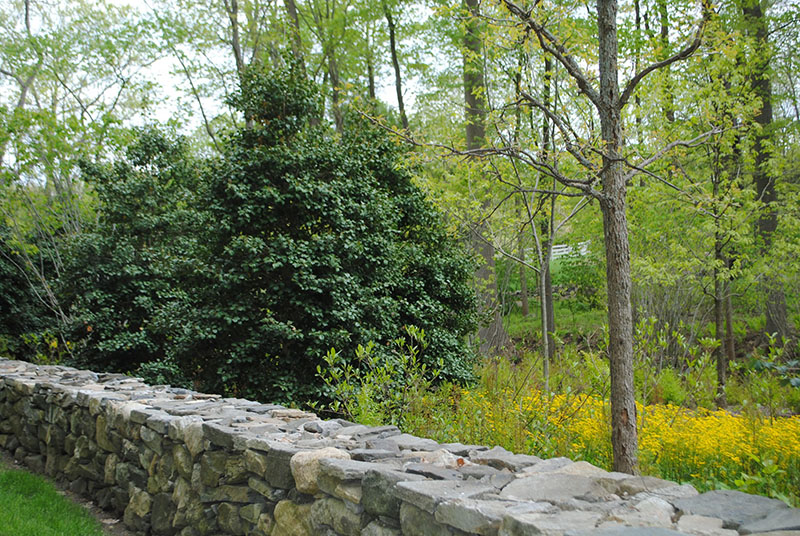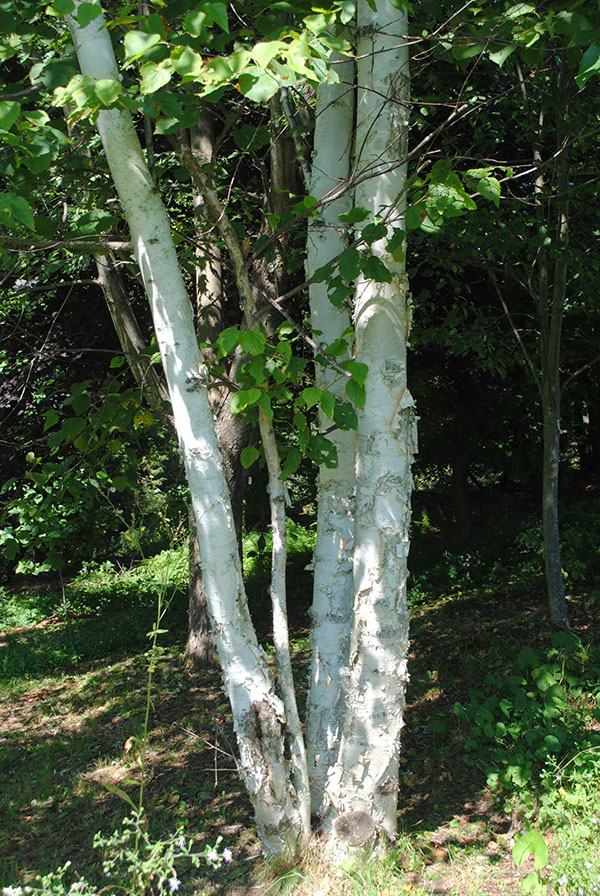By Kate Brittenham
Though the ground may be frozen (and if you are lucky, covered with a picturesque blanket of snow), there can still be interest in our gardens, both for us and for wildlife. We have compiled a sample list of native shrubs and trees that should be recognized for their beauty even in the dead of winter. There are so many more, but we had to limit ourselves!
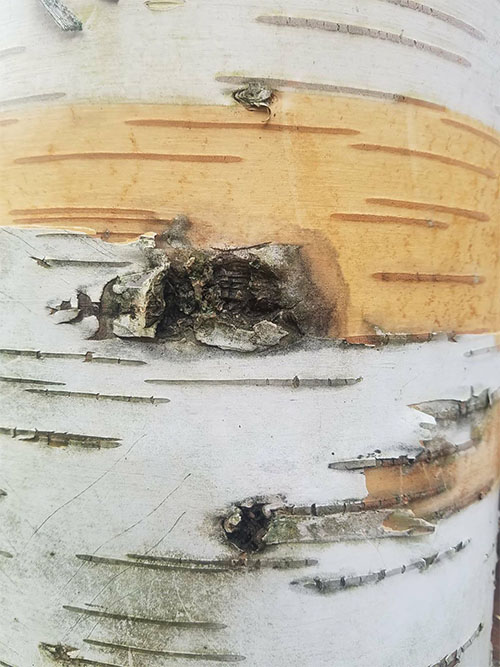 Betula papyrifera (Paperbark Birch)
Betula papyrifera (Paperbark Birch)
I’d like to go by climbing a birch tree,
And climb black branches up a snow-white trunk
Toward heaven, till the tree could bear no more,
But dipped its top and set me down again.
That would be good both going and coming back.
One could do worse than be a swinger of birches.
Excerpt from Birches by Robert Frost
Growing up, Betula papyrifera (Paperbark Birch) was one of my absolute favorite trees, because it created the best props for an uninhibited imagination. The peeling bark became the paper for my secret messages or ancient treasure maps. It was bracelets and necklaces or dinner plates. The options were limitless! I remember one children’s book in particular that I grew up with—The Rough-Faced Girl—an Algonquin take on the Cinderella story, where the heroin actually makes a dress out of birchbark.
As an adult, I still have a great appreciation for the beautiful bark of this tree. Incredibly easy to identify due to its peeling, papery bark, Betula papyrifera enhances the winter landscape. Use it as an accent tree or in a mass, it will stand out regardless. An allee of these trees easily creates a winter wonderland. Place it against a backdrop of evergreens, or pair it with shrubs like Ilex verticillata or Swida sericea that will pop against the pearly white bark.
Rhus typhina (Staghorn Sumac)
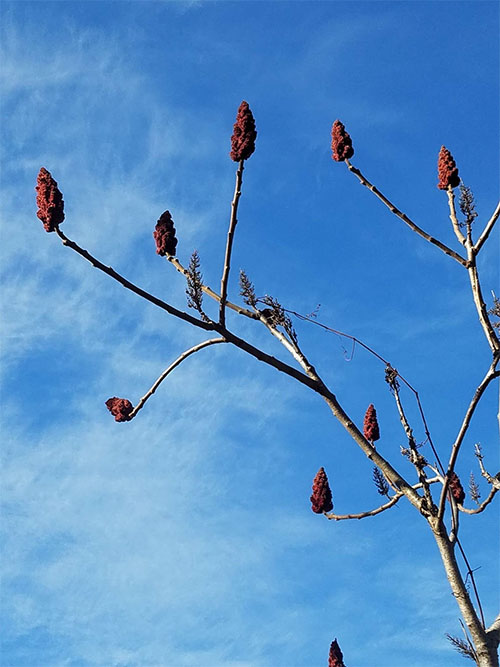 A very underrated shrub and frequently dismissed as a landscape plant, probably due to its “weedy” character and atypical appearance, Rhus typhina might not look like your typical garden plant, but the shrub provides valuable habitat for songbirds, who feed on its seedheads. It is named for the small hairs that grow along the younger branches, creating a fuzzy texture, not unlike the “velvet” on the horns of a stag.
A very underrated shrub and frequently dismissed as a landscape plant, probably due to its “weedy” character and atypical appearance, Rhus typhina might not look like your typical garden plant, but the shrub provides valuable habitat for songbirds, who feed on its seedheads. It is named for the small hairs that grow along the younger branches, creating a fuzzy texture, not unlike the “velvet” on the horns of a stag.
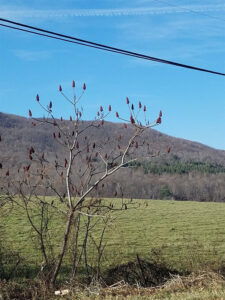
It is listed here for the unique red conical fruit, which stands out in stark contrast in the wintery landscape. Throughout the season, Rhus typhina is foliated by large, long, and pinnately shaped leaves, which turn to a nice red in the fall, but drop with the temperature. What is left through the winter season are the fruits, which make for great dried and fresh arrangements.
Largest of the North American sumacs, Rhus typhina typically grows 15-20’ in height. It will spread and form stands, making it an excellent choice to create groves or thickets in the landscape.
Hydrangea quercifolia (Oakleaf Hydrangea)
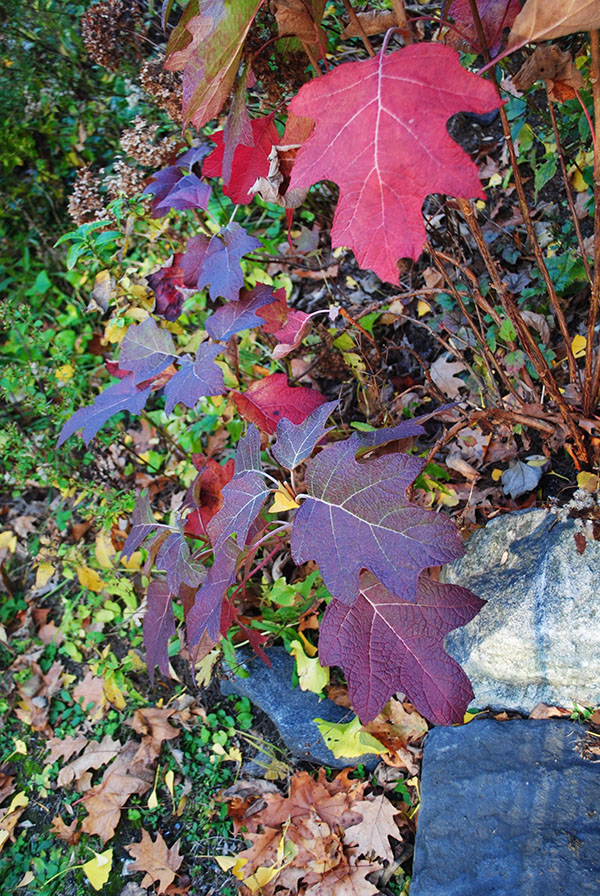 I will begin this section with a disclaimer: I have never been a fan of hydrangeas. I always thought they were too 1960s suburbia, until I began working with plants and it was this particular species, the Oak Leaf Hydrangea, that first brought me around. The moment I truly recognized their beauty was during a trip to the New York Botanical Garden in early spring, when very little was awake. The bark of Hydrangea quercifolia was absolutely striking at this point in the season and I was forever after a convert.
I will begin this section with a disclaimer: I have never been a fan of hydrangeas. I always thought they were too 1960s suburbia, until I began working with plants and it was this particular species, the Oak Leaf Hydrangea, that first brought me around. The moment I truly recognized their beauty was during a trip to the New York Botanical Garden in early spring, when very little was awake. The bark of Hydrangea quercifolia was absolutely striking at this point in the season and I was forever after a convert.
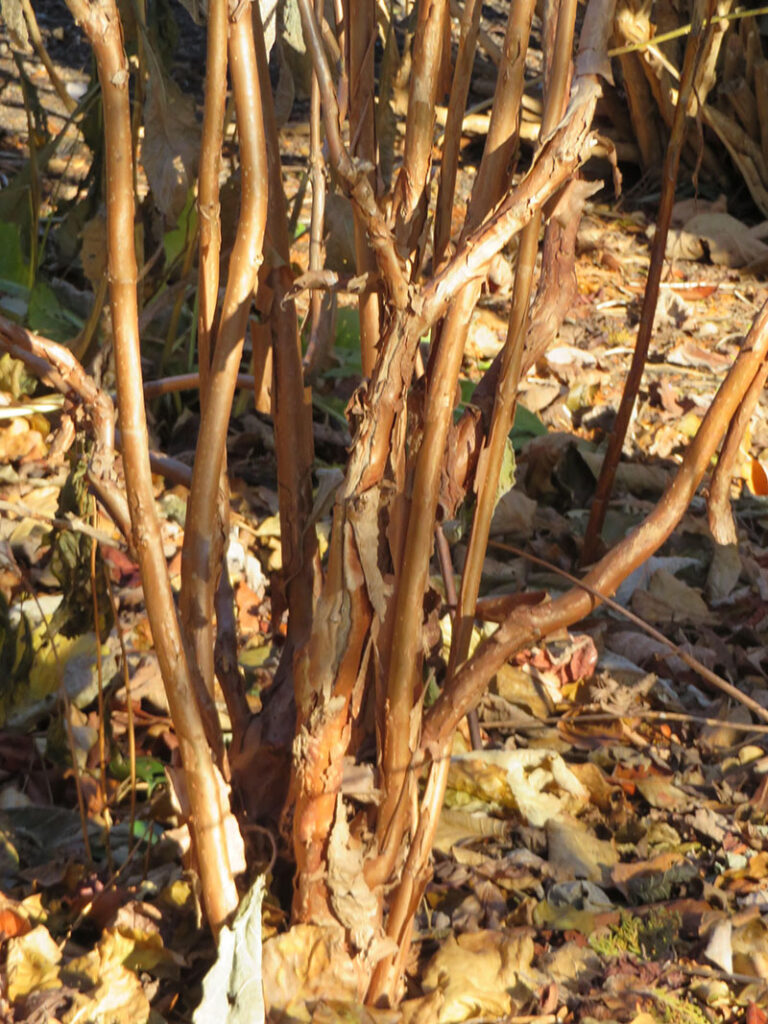 Hydrangea quercifolia is an absolutely fantastic landscape plant that has really gained in popularity in recent years, due to its versatility and seasonal interest: a great filler shrub, spreading up to 6-8ft in width and height, it is drought tolerant once established, and performs in part shade as well as full sun. Low maintenance and deer resistant, Hydrangea quercifolia produces lovely late season blooms, and the characteristic oak-shaped leaves change to a lovely red or deep purple in the autumn, as shown above.
Hydrangea quercifolia is an absolutely fantastic landscape plant that has really gained in popularity in recent years, due to its versatility and seasonal interest: a great filler shrub, spreading up to 6-8ft in width and height, it is drought tolerant once established, and performs in part shade as well as full sun. Low maintenance and deer resistant, Hydrangea quercifolia produces lovely late season blooms, and the characteristic oak-shaped leaves change to a lovely red or deep purple in the autumn, as shown above.
In the early winter, the blooms will remain dried on the stalks, and make for excellent additions to a dried flower arrangement. The pale brown and beige bark provides interest throughout the winter, peeling in layers similar to Betula papyrifera, and is truly beautiful against the snow. There are many cultivars and ‘Snow Queen’ in particular is a great option for even more distinct bark coloration and peeling. Pictured above is the straight species.
Swida sericea (Red Osier or Red-Twig Dogwood)
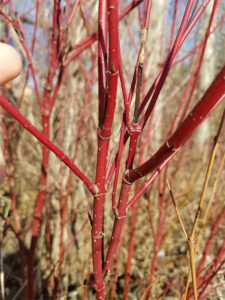 This is a plant meant for the winter landscape. A thicket-forming shrub, it creates horizons of red wherever it grows and does well in a variety of conditions. I have seen it happily established along the slopes of medians on I-87 in upstate New York, but it is happiest in moist to wet soils, like marshes and wetlands. An erosion stabilizer, it is also a great rain garden plant. Best grown in masses, and pairs well with grasses and perennials with grass-like foliage, like Amsonia hubrichtii and tabernaemontana—particularly in the fall and winter. It also pairs well with evergreens like Ilex opaca for a bit of that holiday color.
This is a plant meant for the winter landscape. A thicket-forming shrub, it creates horizons of red wherever it grows and does well in a variety of conditions. I have seen it happily established along the slopes of medians on I-87 in upstate New York, but it is happiest in moist to wet soils, like marshes and wetlands. An erosion stabilizer, it is also a great rain garden plant. Best grown in masses, and pairs well with grasses and perennials with grass-like foliage, like Amsonia hubrichtii and tabernaemontana—particularly in the fall and winter. It also pairs well with evergreens like Ilex opaca for a bit of that holiday color.
A host for the larvae of the Spring Azure (Celastrina ladon) butterfly, in the late spring, the small flowers attract pollinators and later, turn to berries that the birds love. The berries have high nutritional value and ripen just around the time that the birds migrate. Still not convinced of its landscaping value? For those of you who live in deer-inundated areas, Swida sericea is deer resistant—although not deer proof (very few plants truly are).
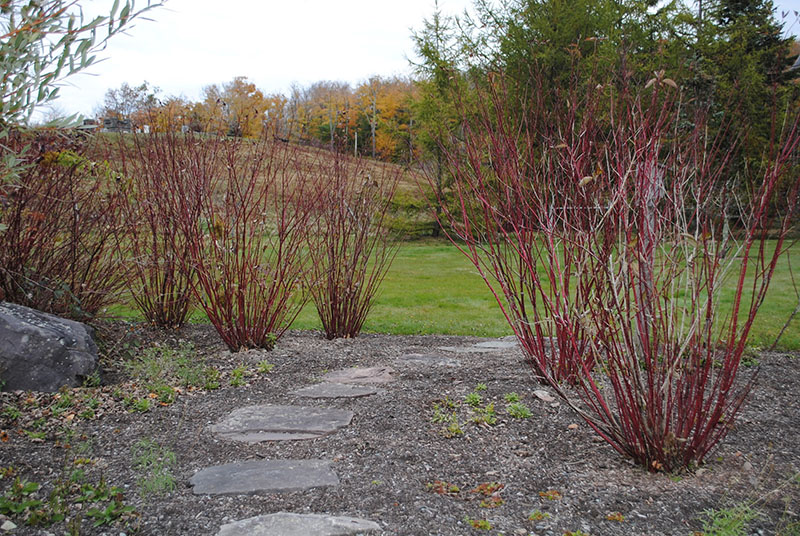
A little bit of fun history: the twigs have historically been used in baskets, which I can imagine would be beautiful with that red color, assuming it lasts. (As the plants age, older twigs become brown; judicious pruning renews red stems.) The common name “osier” comes from the name given to willow twigs that were used to create baskets.
Ilex verticillata (Winterberry)
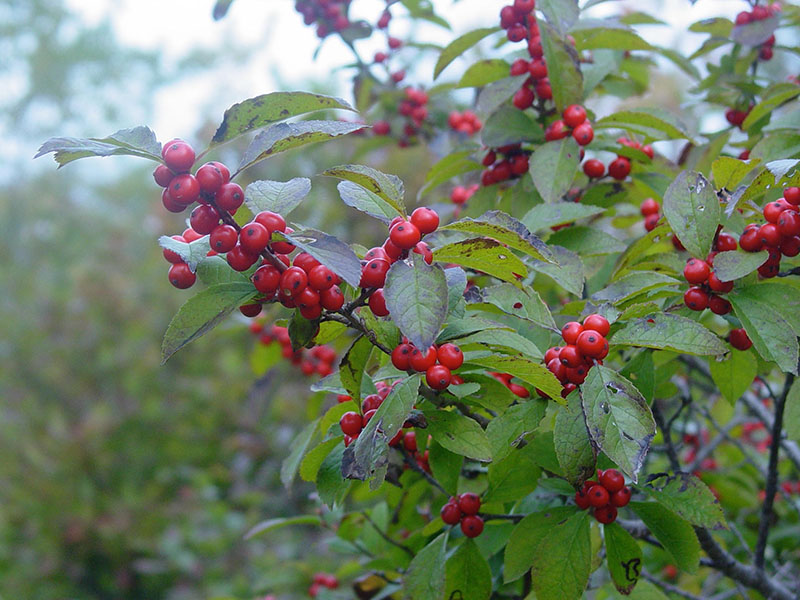 Without fail, the top plant for winter interest, in my opinion, is Ilex verticillata. When anyone asks me for winter interest, this beautiful plant immediately comes to mind. For most of the growing season, it is a relatively understated background shrub, with a nice shape and lovely foliage, but nothing striking. Its true landscape purpose emerges in late fall and early winter, when the leaves fall and the bright red berries (a favorite of songbirds) become visible. Commonly used in holiday decorations and arrangements, popular among floral designers, Ilex verticillata is a requisite for the winter garden.
Without fail, the top plant for winter interest, in my opinion, is Ilex verticillata. When anyone asks me for winter interest, this beautiful plant immediately comes to mind. For most of the growing season, it is a relatively understated background shrub, with a nice shape and lovely foliage, but nothing striking. Its true landscape purpose emerges in late fall and early winter, when the leaves fall and the bright red berries (a favorite of songbirds) become visible. Commonly used in holiday decorations and arrangements, popular among floral designers, Ilex verticillata is a requisite for the winter garden.
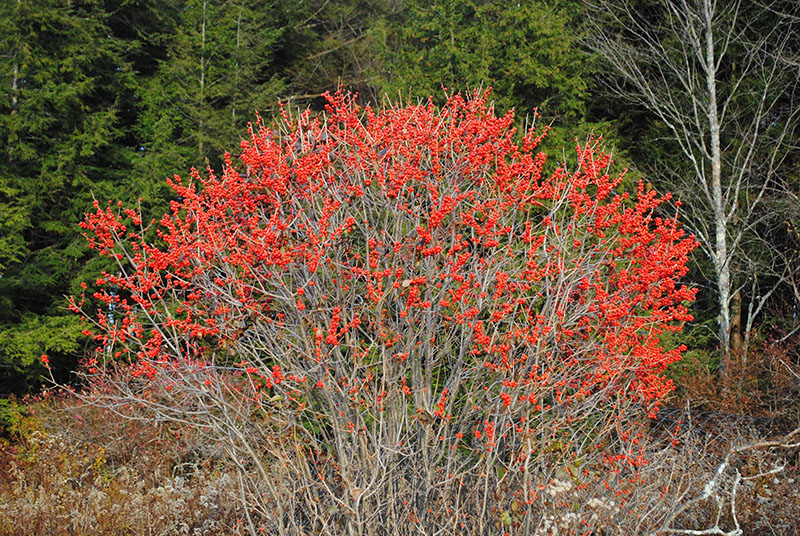 In the wild, Ilex verticillata can grow quite tall, to about the height of a small tree, however there are many dwarf varieties available on the market. One lovely (and easy to find) dwarf cultivar is ‘Red Sprite’. It is important to note that, like all hollies, Ilex verticillata is dioecious, meaning that the flowers on one shrub will be all female, and all male on another. In other words, in order to get those beautiful berries, both male and female shrubs are necessary. A good male cultivar that will pollinate happily ‘Red Sprite’ is the ‘Southern Gentleman’ cultivar. For larger sized shrubs, both ‘Winter Red’ and ‘Jolly Red’ produce bountiful berry-laden branches.
In the wild, Ilex verticillata can grow quite tall, to about the height of a small tree, however there are many dwarf varieties available on the market. One lovely (and easy to find) dwarf cultivar is ‘Red Sprite’. It is important to note that, like all hollies, Ilex verticillata is dioecious, meaning that the flowers on one shrub will be all female, and all male on another. In other words, in order to get those beautiful berries, both male and female shrubs are necessary. A good male cultivar that will pollinate happily ‘Red Sprite’ is the ‘Southern Gentleman’ cultivar. For larger sized shrubs, both ‘Winter Red’ and ‘Jolly Red’ produce bountiful berry-laden branches.
Ilex opaca (American Holly)
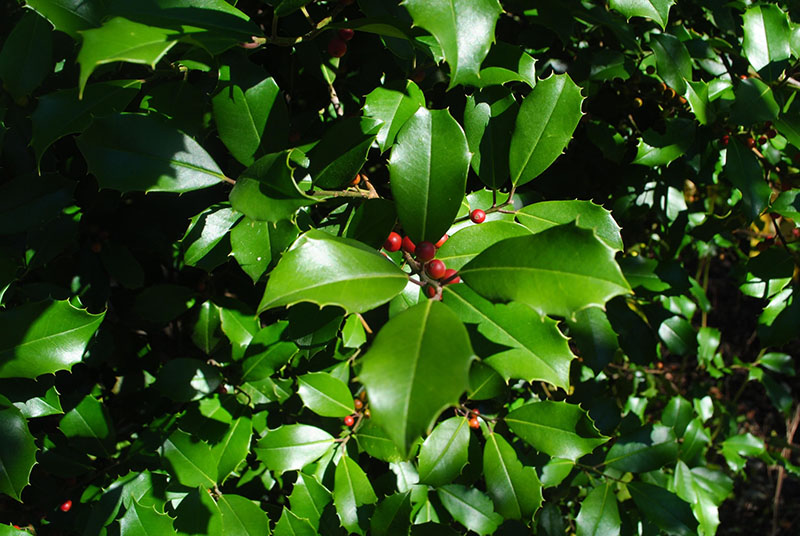 I have heard that many people hold the opinion that the American Holly is not as nice as the English, but I personally do not understand that perception. I think to the untrained eye, they are nearly indistinguishable, and Ilex opaca provides a marvelous substitute for the English. Its classic spikes, green color and vibrant berries evoke the spirit of the winter season. It is also deer resistant—you would have to be incredible hungry to tangle with those spiky leaves.
I have heard that many people hold the opinion that the American Holly is not as nice as the English, but I personally do not understand that perception. I think to the untrained eye, they are nearly indistinguishable, and Ilex opaca provides a marvelous substitute for the English. Its classic spikes, green color and vibrant berries evoke the spirit of the winter season. It is also deer resistant—you would have to be incredible hungry to tangle with those spiky leaves.
Ilex opaca is considered a shrub, but will grow quite tall and in a pyramidal shape. It can be trained to stay low but there are also cultivars such as ‘Maryland Dwarf’ and ‘Clarendon Spreading’ that are natural dwarves. Ilex opaca can also be pruned into a hedge-shape. Again, as an Ilex, the American Holly requires both male and female plants in order to produce berries. Put it in full sun or part shade, it will happily grow in either condition.
